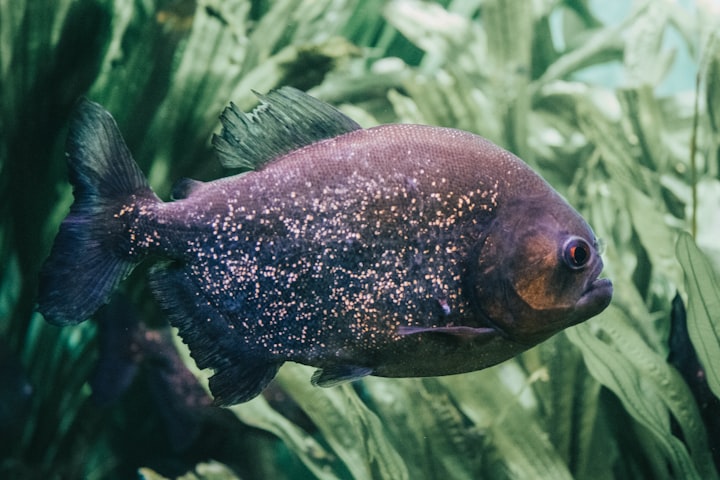Piranhas
Separating Fact from Fiction in the Amazon River

Picture yourself peering into the majestic waters of the Amazon River, surrounded by the lush greenery of the rainforest. Suddenly, you lose your footing and find yourself tumbling into the river. As you splash into the water, a chilling thought crosses your mind: piranhas, those notorious flesh-eating fish, are rumored to inhabit these waters. Are you doomed? Will your fall trigger a fatal feeding frenzy?
To forecast your fate accurately, let's delve into what we know about these infamous fish. The Amazon River is home to more than 30 piranha species, each possessing a single row of sharp, interlocking teeth on each jaw. These teeth serve a variety of purposes, as piranhas exhibit diverse dietary habits, behaviors, and social structures.
Piranha Diversity and Diet
Many piranha species are omnivorous, supplementing their diets of insects, crustaceans, worms, and fish with fruits, seeds, and other plant matter. Some, like the red-bellied piranhas, are both skilled hunters and scavengers. In contrast, others, such as the wimple piranhas, have specific dietary preferences, often exclusively targeting the scales of other fish.
Social Behavior
Piranhas also vary in their social behaviors. Some species, like the redeye piranhas, are more solitary, while others, like the red-bellied piranhas, form shoals of 10 to 100 individuals. Interestingly, the perception that red-bellied piranhas are particularly aggressive due to their group behavior is somewhat misplaced. Their group-living primarily serves as protection from numerous predators in their environment. Larger, mature red-bellied piranhas often take positions at the center of the shoal for safety, and smaller groups of these fish tend to exhibit more anxious behavior.
Communication Among Piranhas
Piranhas are not just silent predators; they also communicate with one another. They produce rapid contractions of specialized muscles above their swim bladders, resulting in distinctive "barks" during confrontations or when captured. These fish make thudding noises during aggressive interactions, such as circling, fighting, or competing for food. These sounds are believed to be only a fraction of their communication repertoire, which may have unique functions during mating rituals.
Piranhas and Humans
But when do red-bellied piranhas become aggressive towards humans? Incidents involving piranha bites often occur when people handle these fish, spill food or clean fish in the water, or disturb piranhas during mating or egg-guarding activities in the wet season. Starvation stress can also lead to more bold and aggressive behavior in piranhas, potentially resulting in feeding frenzies.
Theodore Roosevelt's Influence
The international infamy of piranhas, particularly red-bellied piranhas, can be traced back to former US President Theodore Roosevelt. In 1914, he published a bestselling book in which he sensationalized piranhas as "the most ferocious fish in the world" and claimed that they could devour an entire cow or even a human alive if they smelled blood. However, Roosevelt's account is now considered circumstantial and misleading. It is suspected that the so-called "feeding frenzy" he witnessed was staged by deliberately starving piranhas and then providing them with a cow carcass for a dramatic spectacle.
Your Fate in Piranha-Infested Waters
So, what would likely happen if you were to fall into piranha-infested waters, assuming they are red-bellied piranhas? Fortunately, in the Amazon River, these fish should have an ample food supply, so they are not likely starving. Moreover, you are not hitting the water amidst a feast of fish guts, and you are not disrupting their breeding activities.
In such a scenario, piranhas would most likely avoid you. Experts recommend calmly and softly swimming or wading to shore because splashing can attract piranhas. While piranhas possess the capability to inflict harm, they rarely attack humans, as they typically have more readily available food sources in their natural habitat. As you make your way to dry land, you will likely find no feeding frenzy where your body is skeletonized within minutes, and upon exiting the water, you'll probably be relieved to find no chunks of flesh missing.
Conclusion
The notorious reputation of piranhas as merciless killers is a product of sensationalized accounts and myths. While these fish do possess impressive teeth and hunting skills, they are not the mindless man-eaters often depicted in popular culture. In the Amazon River and its tributaries, piranhas are an essential part of the ecosystem, playing a role in maintaining the balance of aquatic life. So, if you ever find yourself in the Amazon and encounter these fascinating creatures, remember that your chances of survival are far better than the myths suggest.





Comments
Melody Martin is not accepting comments at the moment
Want to show your support? Send them a one-off tip.